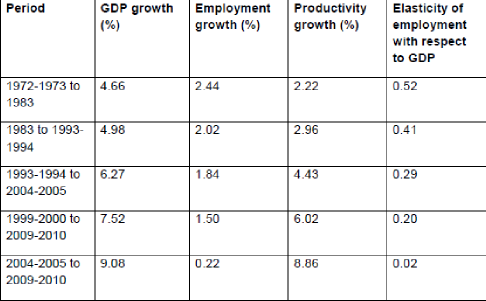Answer:
The process of liberalization, which began in 1990s is seen as a milestone in the economic history of India. Since the liberalization, the economic condition gradually started improving and today India is one of the fastest growing economies in the world with an average yearly growth rate of around 6-7 per cent.
Theoretically, acceleration in GDP growth of a labour-abundant country characterised by the market regime should push employment growth rate as well. However the impact of liberalisation on growth of employment in India is not as per the expectations.
A comparative analysis of GDP growth rate and employment growth rate is given below:

♤ It is clear from the above table that even though the liberalisation process has resulted in higher economic growth, the growth in employment rate has declined.
♤ Even during the high economic growth phase of 2005-12, employment growth rate was just 0.4% with the addition of just 13 million jobs. There has been continuous decline in employment elasticity as well. It declined sharply from 0.3 during 2000- 05 to 0.05 during 2005-12.
♤ Most of the new jobs were located in the informal sector with low earnings and no social protection resulting in casualization of jobs.
♤ In the economy as a whole, the worker-population ratio declined in the 1990s for men and women in rural and urban areas in most age groups in the range 5-59.
♤ Amongst the young school participation has increased as child and youth labour have declined.
♤ There is an across the-board improvement in the growth rate of labour productivity and wages and it is estimated that average per capita earnings per annum increased.
♤ However the liberalization process has mainly benefited the top 10 per cent of wage earners who now make 12 times more than the bottom 10 per cent, up from a ratio of six in the 1990s.
♤ As per the NSSO data, only 18% of working people have regular wage salary employment. Roughly 30% are casual labourers, dependent on daily or periodic renewal of job opportunities. The remaining 52% are self-employed. Most of them are in agriculture, working as helpers in family owned businesses without salary.
♤ Employment share of public sector has gradually reduced as the public sector withdrew from many areas. A healthy growth rate in employment has been registered in the private sector.

♤ The liberalisation and globalisation process brought in more technological upgrades in manufacturing sector which increased the mechanisation and reduced the employment.
♤ In case of service sector, the employment growth has not matched the growth in GDP contribution. The sector presently contributes nearly 55% of total GDP but has employed a mere 27%. The problem of skill development enabling labour migration to services remains inadequately addressed.
♤ The conditions of employment in unorganised sector have not improved. The middlemen and employer continue to enjoy the benefits derived from their labour.
♤ In the Index of Economic Freedom World Rankings for 2013, India was ranked 119th among 177 countries, putting India in the category of ‘mostly unfree’ countries. The report clearly states that although there is improvement in labour freedom, it is offset by declining scores in other areas. Further, the report states that corruption is endemic throughout the economy and is becoming more serious.
